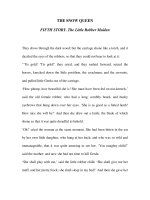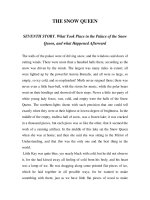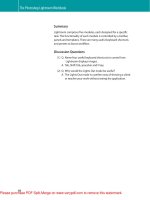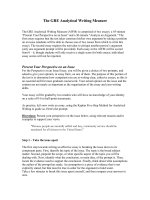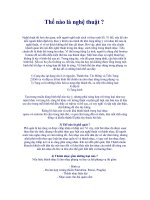Tài liệu The Dynamic Retention Model for Air Force Officers- New Estimates and Policy Simulations of the Aviator Continuation Pay Program doc
Bạn đang xem bản rút gọn của tài liệu. Xem và tải ngay bản đầy đủ của tài liệu tại đây (486.96 KB, 85 trang )
This document and trademark(s) contained herein are protected by law as indicated in a notice appearing later in
this work. This electronic representation of RAND intellectual property is provided for non-commercial use only.
Unauthorized posting of RAND PDFs to a non-RAND Web site is prohibited. RAND PDFs are protected under
copyright law. Permission is required from RAND to reproduce, or reuse in another form, any of our research
documents for commercial use. For information on reprint and linking permissions, please see RAND Permissions.
Limited Electronic Distribution Rights
This PDF document was made available from www.rand.org as a public
service of the RAND Corporation.
6
Jump down to document
THE ARTS
CHILD POLICY
CIVIL JUSTICE
EDUCATION
ENERGY AND ENVIRONMENT
HEALTH AND HEALTH CARE
INTERNATIONAL AFFAIRS
NATIONAL SECURITY
POPULATION AND AGING
PUBLIC SAFETY
SCIENCE AND TECHNOLOGY
SUBSTANCE ABUSE
TERRORISM AND
HOMELAND SECURITY
TRANSPORTATION AND
INFRASTRUCTURE
WORKFORCE AND WORKPLACE
The RAND Corporation is a nonprofit research
organization providing objective analysis and effective
solutions that address the challenges facing the public
and private sectors around the world.
Visit RAND at www.rand.org
Explore RAND Project AIR FORCE
View document details
For More Information
Purchase this document
Browse Books & Publications
Make a charitable contribution
Support RAND
This product is part of the RAND Corporation technical report series. Reports may
include research findings on a specific topic that is limited in scope; present discus-
sions of the methodology employed in research; provide literature reviews, survey
instruments, modeling exercises, guidelines for practitioners and research profes-
sionals, and supporting documentation; or deliver preliminary findings. All RAND
reports undergo rigorous peer review to ensure that they meet high standards for re-
search quality and objectivity.
The Dynamic
Retention Model for
Air Force Officers
New Estimates and
Policy Simulations of the
Aviator Continuation
Pay Program
Michael Mattock, Jeremy Arkes
Prepared for the United States Air Force
Approved for public release; distribution unlimited
PROJECT AIR FORCE
The RAND Corporation is a nonprofit research organization providing objective analysis
and effective solutions that address the challenges facing the public and private sectors
around the world. RAND’s publications do not necessarily reflect the opinions of its
research clients and sponsors.
R
®
is a registered trademark.
© Copyright 2007 RAND Corporation
All rights reserved. No part of this book may be reproduced in any form by any electronic or
mechanical means (including photocopying, recording, or information storage and retrieval)
without permission in writing from RAND.
Published 2007 by the RAND Corporation
1776 Main Street, P.O. Box 2138, Santa Monica, CA 90407-2138
1200 South Hayes Street, Arlington, VA 22202-5050
4570 Fifth Avenue, Suite 600, Pittsburgh, PA 15213-2665
RAND URL:
To order RAND documents or to obtain additional information, contact
Distribution Services: Telephone: (310) 451-7002;
Fax: (310) 451-6915; Email:
Library of Congress Cataloging-in-Publication Data
Mattock, Michael G., 1961-
The dynamic retention model for Air Force officers : new estimates and policy simulations of the aviator
continuation pay program / Michael Mattock, Jeremy Arkes.
p. cm.
Includes bibliographical references.
ISBN 978-0-8330-4158-6 (pbk. : alk. paper)
1. United States. Air Force—Recruiting, enlistment, etc. 2. United States. Air Force—Pay, allowances, etc.
I. Arkes, Jeremy. II. Title.
UG883.M38 2007
358.4'332—dc22
2007027895
The research described in this report was sponsored by the United States Air Force under
Contracts FA7014-06-C-0001 and F49642-01-C-0003. Further information may be
obtained from the Strategic Planning Division, Directorate of Plans, Hq USAF.
iii
Preface
e U.S. Air Force (USAF) needs to attract, promote, and retain the appropriate quantity and
quality (e.g., experience level) of officers to execute current and future missions. e pay and
promotion system is a key tool in officer retention efforts. e USAF needs to be able to assess
the probable effects of changes in pay and promotion policies on the future retention of USAF
officers before actually implementing proposed changes.
erefore, the Air Force is interested in models that can simulate the effects changes in
pay and promotion policy might have on officer retention. is technical report documents
a particular type of model, the dynamic retention model (DRM) developed by Glenn A.
Gotz and John Joseph McCall in A Dynamic Retention Model for Air Force Officers: eory
and Estimates, RAND Corporation, R-3028-AF, 1984, and the extension of the basic DRM
to take into account the effect of the availability of multiyear contracts to certain classes of
Air Force officers. Unlike other models, the DRM takes into account the value an officer may
place on future career flexibility and thus is particularly well suited to examining the effect of
bonus programs that have service commitments, such as the Aviator Continuation Pay (ACP)
program.
e model described in this report was initially developed for a fiscal year (FY) 2003
project, “Officer Retention and Experience,” sponsored by Lt Gen Roger A. Brady, Deputy
Chief of Staff, Personnel, Headquarters U.S. Air Force (AF/A1). e research was conducted in
the Manpower, Personnel, and Training Program of RAND Project AIR FORCE. e report
should interest those involved in Air Force officer personnel management and those with an
interest in modeling to support development of personnel policies.
RAND Project AIR FORCE
RAND Project AIR FORCE (PAF), a division of the RAND Corporation, is the U.S. Air
Force’s federally funded research and development center for studies and analyses. PAF pro-
vides the Air Force with independent analyses of policy alternatives affecting the development,
employment, combat readiness, and support of current and future aerospace forces. Research is
conducted in four programs: Aerospace Force Development; Manpower, Personnel, and Train-
ing; Resource Management; and Strategy and Doctrine.
Additional information about PAF is available on our Web site at
/>
v
Contents
Preface iii
Figures
vii
Tables
ix
Summary
xi
Acknowledgments
xiii
Abbreviations
xv
CHAPTER ONE
Introduction 1
Background
1
Objective and Research Approach
2
How is Report Is Organized
2
CHAPTER TWO
A Dynamic Retention Model 3
Modeling the Value of Flexibility—An Example
5
Relation of the Dynamic Retention Model to the Aviator Continuation Pay Program
5
A Retention Model
6
Modeling Uncertainty—Taste
7
Modeling Uncertainty—Shocks
8
Concluding Remarks
10
CHAPTER THREE
Comparing the Dynamic Retention Model and the Annualized Cost of Leaving Family
of Models
11
A Simplified DRM
11
Modeling a Five-Year Commitment
12
e Annualized Cost of Leaving 2 Model
13
CHAPTER FOUR
Results of the Dynamic Retention Model 17
Estimating the Parameters
17
Model Estimates
17
vi The Dynamic Retention Model for Air Force Officers
Simulations Based on the Estimates 18
Comparison with the Estimates of Gotz and McCall
21
Conclusions
22
APPENDIXES
A. Implementation Details and Model Estimates 23
B. Computer Program and Data
45
Bibliography
67
vii
Figures
2.1. Influences on Individual Retention Decisions 4
2.2. Simple Retention Model
6
2.3. Modeling Uncertainty
7
2.4. Distribution of Taste for Military Service in Pilot ROTC Graduates
9
2.5. Change in Taste for Service
9
2.6. Distribution of Environmental Shock for Pilots
10
4.1. Observed and Predicted Pilot Retention Rates
18
4.2. Observed and Predicted Pilot Retention Rates for Non-ROTC Accessions
19
4.3. Observed and Predicted Pilot Retention Rates for ROTC Accessions
19
4.4. Simulating the Effect of a 10-Percent Pay Cut for Pilots
20
4.5. Simulated Effect of Eliminating the 20-Year Option for Pilots
21
4.6. Simulating Elimination of the ACP Program for Pilots
21
A.1. R Implementation of the ACP DRM
34
A.2. Observed and Predicted Retention Rates for Mission Support Officers
38
A.3. DRM and ACOL 2 Predicted Cumulative Retention Rates for Pilots
39
A.4. DRM and ACOL 2 Predicted-Actual Cumulative Continuation Rates for Pilots
39
A.5. DRM and ACOL Simulations of the Effect of a 10-Percent Pay Cut for Pilots
40
A.6. DRM and ACOL Simulations of the Effect of Eliminating the 20-Year Option
for Pilots
41
A.7. DRM and ACOL Simulations of the Effect of Eliminating ACP for Pilots
41
A.8. DRM and ACOL 2 Predicted Cumulative Retention Rates for Mission Support
Officers
42
A.9. DRM and ACOL Simulations of the Effect of 10-Percent Pay Cut for Mission
Support Officers
42
ix
Tables
A.1. MLE Estimates for Pilot ACP DRM 36
A.2. MLE Estimates for Mission Support Officers
37
B.1. Data Dictionary for Pilot Data
62
B.2. Pilot Data
62
xi
Summary
All the military services face problems retaining the number of quality officers they need to
support current and future needs. In the USAF, the problem is most acute in the case of pilots,
information technology specialists, scientists, and engineers. e USAF developed a pay incen-
tive program to induce pilots to remain in the service. e ACP program pays an annual bonus
to pilots who commit to certain terms of service. e ACP program has been expanded to
certain groups of navigators and air battle managers. Generally the bonuses are paid to officers
who agree to extend their service for specified numbers of years (e.g., three or five) or to a speci-
fied length of service, (e.g., 25 years of aviation service [YAS]).
Accurate models are needed to help the USAF develop retention policies that will retain a
sufficient number of officers having the right qualities. e Air Force, and researchers working
on personnel issues for the Air Force and other services, have long used an annualized cost of
leaving (ACOL) model to help determine how changes in compensation would affect reten-
tion. However, the ACOL model does not handle two important factors in retention decisions
particularly well: future uncertainty and random “shocks.”
e advantage of the DRM is that it allows us to model how officers might value future
career flexibility in the face of uncertainty. is is important in evaluating how people will
respond to contracts that obligate them to multiple years of service, such as those available
under the ACP program. Advances in computer hardware and software have now made esti-
mation of the DRM feasible on even low-end personal computers.
e DRM can be used to explore different policy options by taking individual retention
decisions and running them through various policy alternatives. For example, it can analyze
the effect of proposed changes to the ACP program, such as eliminating the until-20-YAS
option or the elimination of the ACP program altogether. e DRM shows that eliminating
the until-20-YAS option (while keeping the five-year contract option) results in only a small
change to overall retention, while eliminating the ACP program altogether would result in the
Air Force losing up to 15 percent of its most experienced officers.
1
We have included the full model code and associated data in Appendix B; this should
enable workers in the field of officer retention to readily replicate the results reported here,
1
As of FY 2005, the until-20-YAS option is no longer available, and only initially eligible officers can take the five-year
option.
xii The Dynamic Retention Model for Air Force Officers
enhance and extend the model, and run simulations exploring different policy alternatives
(e.g., changes to the retirement system) from those covered in this technical report.
Conclusions
e DRM fits the data. Our extension of the DRM to cover ACP offers the Air Force an effec-
tive tool with which to analyze how officers respond to multiyear agreements. Computer code
is now readily available to implement the model. We recommend that the Air Force adopt the
model and consider widening its application.
xiii
Acknowledgments
e authors would like to acknowledge the help of Glenn Gotz, Craig Moore, and especially
Maj Kevin errien, Chief of Rated-Force Policy for Mobile Forces, U.S. Air Force, all of
whom provided timely advice, feedback, and salient examples for demonstrating the capabili-
ties of the DRM. We would also like to thank Al Robbert, Jim Hosek, John Ausink, Beth
Asch, and Jerry Sollinger, who provided advice and encouragement during the long gestation
of this technical report.
is report is dedicated to the memory of Glenn Gotz, who passed away during its prepa-
ration. We hope that this report will lead to a wider recognition and appreciation of the funda-
mental contribution that his work in collaboration with John McCall made to econometrics in
general and military manpower research in particular. He was a man truly ahead of his time.
He will be sorely missed.
xv
Abbreviations
ABM air battle manager
ACOL annualized cost of leaving
ACP aviator continuation pay
BFGS Broyden-Fletcher-Goldfarb-Shanno
CPS Current Population Survey
DRM dynamic retention model
EM expectation-maximization
FY fiscal year
GEM generalized expectation-maximization
MAP maximum a priori
MLE maximum likelihood estimator
PAF Project AIR FORCE
ROTC Reserve Officer Training Corps
USAF United States Air Force
YAS years of aviation service
YOS years of service
1
CHAPTER ONE
Introduction
Background
In testimony before the House Armed Services Committee in July 2001, the Chief of Staff
of the Air Force cited retention as the most pressing problem facing the Air Force. Retaining
pilots, information technology specialists, scientists, and engineers was proving particularly
difficult. Several years ago, the Air Force developed a pay incentive program to induce pilots to
remain in the service: e Aviator Continuation Pay (ACP) program paid an annual bonus to
pilots who committed to certain terms of service.
1
Subsequently, the program was expanded to
include not only pilots but also certain groups of navigators and air battle managers (ABMs).
ACP agreements are now offered to navigators with at least 15 years of aviation service (YAS)
and 18 or more years of total active-duty military service. Eligible navigators are offered three-
year agreements at $10,000 per year, five-year agreements at $15,000 per year, and agreements
that they complete 25 years of aviation service at $15,000 per year. Navigators with 20 or more
years of aviation service are eligible to commit to three years of service at the low rate, $10,000
per year, or to agree to remain until they have completed 25 years of aviation service at the high
rate, $15,000 per year, if the agreement is greater than three years.
e Air Force and researchers working for the Air Force have long used an annualized
cost of leaving (ACOL) model to help to determine how officers would react to pay raises, and
it worked relatively well for that purpose. However, analyzing the effects of incentives such as
the ACP program is a more complicated endeavor: It is not simply a matter of modeling reac-
tions to a pay raise but also must account for the effects of forgoing other options. In the case
of a pilot, for example, remaining in the Air Force under an ACP agreement means that he
or she is giving up the opportunity to fly civilian airliners. e ACOL family of models does
not allow modeling the value that pilots would place on future career flexibility, hence a new
model is needed.
1
Department of the Air Force, Aviator Continuation Pay (ACP) Program, Air Force Instruction 36-3004, Washington,
D.C., February 24, 2000.
2 The Dynamic Retention Model for Air Force Officers
Objective and Research Approach
To develop a set of retention policies that would retain the right number and quality of officers
wanted, researchers need to model how people make retention decisions in an uncertain world.
is research project took an approach based on the Gotz-McCall dynamic retention model
(DRM),
2
extending the basic DRM to cover the possibility of Air Force officers entering into
multiyear contracts in exchange for greater pay.
How This Report Is Organized
Chapter Two describes the characteristics and logic of the DRM. Chapter ree compares the
DRM with the ACOL model, and Chapter Four presents the modeling results. Appendix A
gives the estimates produced by the model, and Appendix B presents the computer code and
data used to estimate the model.
2
Glenn A. Gotz and John Joseph McCall, A Dynamic Retention Model for Air Force Officers: eory and Estimates, Santa
Monica, Calif.: RAND Corporation, R-3028-AF, 1984.
3
CHAPTER TWO
A Dynamic Retention Model
e dynamic retention modeling technique has been available since the late 1970s, but it has
been difficult to use because it is computationally intensive. Advances in both computing soft-
ware and hardware over the last two decades have eliminated this drawback. Using the DRM,
we developed a method for statistically estimating model parameters using historical officer
data and simulating the effect of changes in personnel policies on retention.
A key attribute of this approach is that it focuses on individual behavior. Figure 2.1
shows our concept of the decision process leading to a decision to stay or leave. Two aspects
of the figure merit comment. One is that individual retention decisions result from a complex
interaction of many influences. Certainly, Air Force compensation policies influence a service
person’s decision to stay or leave. However, the strength of that influence varies depending on
the individual. An officer who really enjoys military service (has a “taste” for it) might elect to
remain in the service for less compensation than would an individual with less of a taste for
service. External influences are important as well. If the civilian job market is robust and the
individual’s skills are in demand, then the motivation to leave would be relatively greater than
if the market is poor or the individual’s skills are not prized. A second point worthy of com-
ment (which might seem obvious) is that aggregate or group behavior is driven by individual
decisions. Looking at how individuals make decisions gives us more insight into the retention
process than does studying only the mythical “average” officer.
It is important to focus on the behavior of specific individuals in order to arrive at parame-
ter estimates that describe the preferences of officers with regard to key aspects of their environ-
ment. is is opposed to the typical models, which describe an average response to an external
influence; this average response is the end result of a traditional regression model. Using the
DRM, we model an officer’s decision process and take into account individuals’ attempts to
optimize their futures. By modeling individual decisions, any given parameter estimate is less
dependent on specific policies in effect during the period covered by the data than it would be
using the ACOL method. For example, the DRM examines the effect of both direct pay and
pay that is contingent upon a commitment to stay in the Air Force for a given time period.
Although an individual might find a salary increase of $10,000 per year quite attractive, if
accompanied by an obligation to continue to serve for five more years, it might not be enough
to induce him or her to remain in the service. If we construct a model of the internal decision-
making process of an Air Force pilot that takes into account regular military pay, ACP, and
civilian career opportunities, then estimates of the remaining parameters depend less on these
4 The Dynamic Retention Model for Air Force Officers
factors. is type of model can be used to predict the effect of a broader range of compensa-
tion and personnel policy options. On the other hand, if we construct a retention model for
Air Force pilots that did not include the ACP program in the officer’s decisionmaking calculus,
then the estimates provided by that model could be used with confidence only if all aspects of
the ACP remained unchanged, because the estimated parameters implicitly depend on the spe-
cifics of the ACP program in effect during the period covered by the data used to estimate the
parameters of the model. (By specifics we mean, for example, the amount of the annual bonus,
the amount of the lump sum payment that can be given to officers up-front under some agree-
ments, and the length of the obligated term of service.) Many traditional regression models fall
into this category.
Explicitly modeling individual behavior also allows for the fact that individuals are differ-
ent. People’s behavior can differ as a result of both observable and unobservable characteristics.
For example, an officer’s decision to stay in the military can be affected both by his or her par-
ticular promotion history (an observable characteristic) or his or her taste for military service
(an unobservable characteristic). e DRM allows for differences in both observed and unob-
served characteristics, whereas traditional regression models typically allow for differences only
in observable characteristics.
One of the key features of the DRM is that it explicitly models an officer’s decision cal-
culus as taking into account future uncertainty. (Other models of retention, such as ACOL,
ACOL 2, or the Ausink and Wise “option value” model, do not explicitly include future uncer-
tainty in the officer’s decision calculus.) Including uncertainty enables us to model flexibility—
Figure 2.1
Influences on Individual Retention Decisions
Air Force
policy,
compensation,
benefits
Civilian
Employment
compensation,
benefits,
career track
Individual
quality,
taste
Personnel
match between
supply and
requirements,
career length,
quality,
productivity
Individual
retention
decisions
RAND TR470-2.1
A Dynamic Retention Model 5
the ability to make or change decisions when new information comes to light. is is some-
times referred to as an option value and is a common concept to those who trade in securities.
e ability to buy or sell an option at a particular price has value: It enables a person to hedge
risk. A concrete example may help illustrate this point.
Modeling the Value of Flexibility—An Example
Consider the case of betting on a coin flip. A “heads” means that the individual wins $1, and
a “tails” means $0. us, the expected value of the bet is
1
2
100
1
2
000 050$. $. $."
Now consider a case in which (1) there are two coins that each have an equal chance of coming
up heads or tails and (2) the bettor can chose either coin before it is flipped. e expected value
from choosing a coin is the same as that in the example above, $0.50. However, now consider
the case where the bettor can choose between the two coins after they are flipped. If both come
up heads, the bettor can choose either one and receive $1. If only one comes up heads, the
bettor can choose that one and still receive $1. If both come up tails, then the bettor receives
nothing. e expected value of this bet is $0.75 because three times out of four the bettor can
receive $1. e following formula describes this result:
1
4
100
1
4
100
1
4
100
1
4
000 075$. $. $. $. $."
So the ability to make an informed choice has an expected value of $0.25 ($0.75 – $0.50 =
$0.25). If all anyone cared about was the expected value of the return on the bet, then in order
to get him or her to give up the opportunity to choose after the coins had been flipped, they
would have to be compensated by at least $0.25 because the value of the bet with no choice
($0.50) plus compensation for losing the opportunity to choose ($0.25) would just equal the
value of a bet with choice ($0.75).
1
Relation of the Dynamic Retention Model to the Aviator Continuation Pay
Program
Similarly, if we want to contract officers to stay for an additional five years, we would need to
compensate them for the value of the future choices they are giving up. A five-year contract
means that they would have to forgo any opportunities that they could take advantage of only
1
e authors would like to thank James R. Hosek for this example.
6 The Dynamic Retention Model for Air Force Officers
by leaving the military during that period of time. is compensation may have to be quite
sizable to make people indifferent to the opportunities that they may be forgoing by entering
into a five-year contract, particularly if they can continue to serve on a year-to-year basis. To
get a retention effect for the marginal officer (that is, an officer who is indifferent between stay-
ing and leaving, all other things being equal), we would need to compensate in excess of the
option value.
e exact value of the option value will depend on the size of the random shocks (varia-
tion in civilian opportunities, health events, etc.) officers are subject to year to year. Officers
can experience random shocks from both the civilian and the military side. On the military
side, an officer may receive a good or bad assignment, may be passed over for promotion, and
so on. On the civilian side, an officer may have the opportunity to take a high-paying civilian
position, may see that civilian job opportunities have declined, may find that he or she needs to
leave the service to care for an ailing parent, and so on. While we cannot directly observe the
distribution of these shocks, we can statistically infer distribution of the difference between the
military and civilian shocks in terms of dollars by using the DRM. In general this distribution
will differ for pilots, navigators, and ABMs due to the differences in civilian opportunities for
officers in these three career fields.
A Retention Model
Figure 2.2 depicts a simple retention model.
2
In this model, each officer makes a decision at the
beginning of the period to either stay or leave. If the officer stays, he or she collects the benefits
associated with remaining in the military for a year, including the value of the option to stay or
leave at the next decision point. If the officer leaves, he or she gets the value of a civilian career
path starting in that period. In this simple model behavior is deterministic. is model implic-
itly assumes that officers with identical observable characteristics would behave identically. It
takes no account of the possibility that nominally identical officers might make different deci-
sions about whether to stay or leave.
Figure 2.2
Simple Retention Model
Stay Stay Stay
Leave LeaveLeave
RAND TR470-2.2
2
is discussion parallels the discussion in Gotz and McCall, 1984.
A Dynamic Retention Model 7
Modeling Uncertainty—Taste
is simple retention model is a start, but it is insufficient for our purposes as it does not allow
for differences among individuals. Allowing for differences in individual retention behav-
ior requires the modeling of uncertainty. Figure 2.3 depicts a more sophisticated model that
injects uncertainty and takes into account differences in individuals’ characteristics or in the
environment that an individual faces.
Figure 2.3
Modeling Uncertainty
Stay
Leave
Stay
Leave
Stay
Leave
Stay
Leave
Positive shock
Negative shock
Positive shock
Negative shock
High taste
Low taste
RAND TR470-2.3


